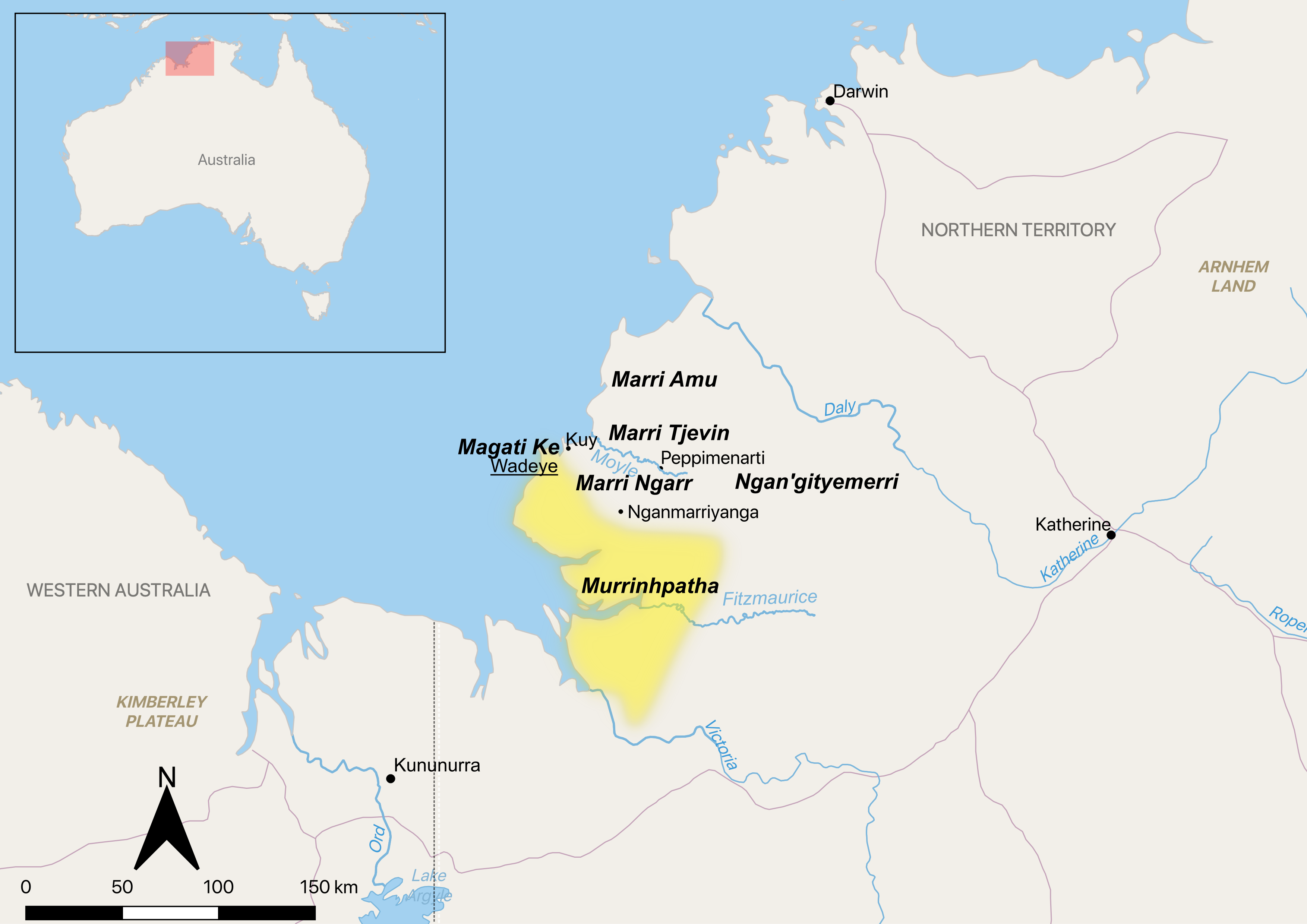Murrinhpatha (aka Murriny Patha or Murrinh-Patha) is the lingua franca spoken by almost all Aboriginal people in the Moyle and Fitzmaurice rivers region of Australia’s Northern Territory. Most of the 3000+ speakers reside in Wadeye, though others live in Darwin, Daly River, Peppimenarti, Nganmarriyanga, Kuy, Yederr, and Kununurra (in Western Australia). As well as by ethnic Murrinhpatha people, the language is used in Wadeye and surrounding communities for daily communication by people whose primary linguistic affiliations are to the Marri Tjevin, Marri Amu, Marri Ngarr, Makati Ke and Jaminjung languages (none of which are being acquired by children). In Wadeye Murrinhpatha is being acquired by children who, prior to encountering English at school, grow up as monolinguals in a largely Murrinhpatha speaking environment. The vast majority of all interactions are conducted in Murrinhpatha. As well as for the non-adoption of English as a language of communication (except in dealings with Europeans), Wadeye is notable for the virtual absence of Kriol.

Murrinhpatha is a non-Pama-Nyungan language belonging to the Southern Daly family. Syntactically, it is a headmarking language with free constituent order. It is also highly polysynthetic, exhibiting both fusional and agglutinating morphology. Murrinhpatha verbs are (generally) complex predicates consisting of an inflecting portion and an uninflecting coverb – tightly bound within a single phonological unit. The verbal subject pronominals are fusional morphemes that additionally function as verbal classifiers. These inflect for 38 different verb classes and six different tense/aspect/mood combinations. With a four-way number distinction, a sibling vs. non-sibling distinction and gender marking for first, second and third persons, Murrinhpatha’s pronouns number in the thousands. All nouns belong to one of ten nominal classes. Murrinh is the nominal classifier pertaining to language and speech. Patha is an adjective meaning “good”. Murrinhpatha thus means “the good language”.
The community of Wadeye is on Murrinhpatha land. Murrinhpatha country extends as far north as Docherty Island at the mouth of Wadeye creek, west to Pearce Point and south of the Fitzmaurice River. The Thamarrurr region that surrounds Wadeye is approximately bounded by the Moyle and Fitzmaurice rivers. As well as these large rivers, the area is crisscrossed by numerous small creeks. Being low-lying country, much of the area is prone to flooding during the monsoonal wet season. The Moyle river forms a very large floodplain. The rising levels of the Moyle and Daly Rivers restrict vehicular access to the region to the driest seven months of the year. Ten kilometres southwest of Wadeye lie the Sugarloaf Ranges and the Macadam ranges are a further forty kilometres in the same direction. The Wingate mountains lie 120 kilometres to the east of Wadeye.
The region is geographically and biologically diverse. Along the coast there are long beaches with coral reefs, as well as areas of mudflats and mangroves. Favourite foods include rock oysters (ku wurldirr), mud crabs (ku balli), longbums (ku thali, Telescopium telescopium), mud clams (ku kunen), mangrove worms (ku warrgi), sharks and stingrays (collectively, ku yeyemam). Further inland there are areas of open woodland, grass plains, waterholes and open swamps. Food from these areas foods include agile wallabies (ku lawarnka), antilopine wallaroos (ku kumpit and ku baybaye for males and females, respectively), goannas (numerous varieties), emus (ku kananganthan), Australian bustards (ku murntuykuy), magpie geese (ku ngalmungkirr), sugarbag (native honey, ku tjithay) and crocodile eggs (ku dumdum).
The Thamarrurr region contains some twentyone patrilineal clans, each of which has their own territorial estates. There are seven clans associated with the Murrinhpatha language, eight with the Marri Ngarr language, two with Marri Tjevin, two with Marri Ammu and two with Magati Ke. On each estate there are several named totemic sites (ngugumingki in Murrinhpatha). These sites and their associated totems (ngakumarl) are jointly owned by all members of the patriclan. Marriage is exogamous to the clan. Language affiliation is determined by the association of a language to these named totemic sites. Musical traditions are important badges of identity. Every person is associated to one of three “mobs” that are in turn named after three public ceremonial genres. Djanba is a genre associated with the Murrinhpatha clans and one Jaminjung clan, Lirrga is associated with the Marri Ngarr clans and some Ngan’giwumirri clans, Wangga is a genre associated with the Marri Tjevin, Marri Ammu and Magati Ke clans and with some other clans associated with languages to the north of the Thamarrurr region.